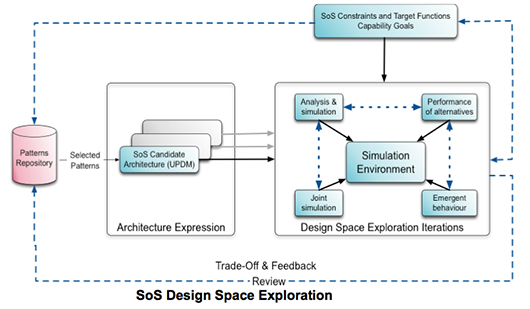Modelling and Simulation

Using architecture patterns to architect and analyze systems of systems
Overview
The inherent nature of a Systems of Systems (SoS) makes them very difficult to model and analyze it through conventional means. One of the first challenges faced is how to represent the SoS in a form that lends itself to detailed analysis, especially when full details of the component systems may not be readily available. Therefore, an important consideration is whether use of model abstractions can be sufficient to deal with many of the analysis needs of the SoS. It is clear there is a need for a new paradigm, encompassing methodology, models, tools and flows that enable the future engineering of SoS in order that they can be operated effectively. We are researching and developing architecture patterns to architect and analyze SoS in order that we can compare different architecture solutions and provide guidelines for the development of a future architectures based on the analysis of existing architectures.
The use of patterns in certain areas of engineering is not new, design patterns have been used by software engineers during the design process and also when communicating designs to others. In essence, a pattern refers to recurring structures, objects and events, although they can also be used as designs, blueprints, models or templates in the construction of other structures, objects and events. In the latter case, newly created entities inherit the characteristics of the parent object (pattern). When used as creational elements, patterns can be used as the starting point to lay basic foundations, but the newly created entity can also evolve or be refined from the original design. Patterns can be descriptions (or templates) that capture practices that have proven successful in the past. It is important to note they are not prescriptive, but suggestive by including guidance on when their use is most appropriate and provides examples from existing systems. The following figure shows a set of command/response patterns. It can be appreciated that whilst these represent a basic command control architecture each patterns offers differing capabilities.

Figure 1: Example ARchitecture Patterns for Command/Control
Technical Approach
Model-based design is becoming increasingly important in systems engineering since model-based methodologies allow system designers to employ abstractions and model representations that match their design concerns rather than be constrained by specific limitations of a particular technological solution. This does not mean that very detailed implementation details can be ignored. However, working at higher abstract levels can help system designers see more clearly the top-level system-to-system interactions. This is particularly helpful in the case of SoS where the lower level implementation details may be hidden from the systems architect. In order to understand and reason about a SoS it is convenient to think in terms of a representational model based on a three-layered stack comprising operational, systems and component models respectively, refer to Fig. 2. At the highest level of abstraction is the operational model that defines the overall system architecture – the system architecture being completely independent of the way the underpinning systems and services are implemented. In essence this is the architectural framework on which the SoS exists. At the next layer down are the underpinning systems models – these are also implementation independent and enable a more specific model to be constructed comprising individual system models. Finally, at the lower level we have the component models that are implementation specific and encapsulate all the variables of a particular solution. Reference to Fig. 2 shows that there is some overlap between the boundaries of the three layers. This framework means that any particular SoS can be represented as an amalgamation of models across these three layers depending on the specific context of interest. An important approach to representing a SoS for analysis purposes is to consider expressing the SoS at systems architectural and systems design levels. The use of three pattern categories: Architectural, Interaction and Design (relating to the three-layered stack as shown in Fig 2) provides a clearer structure for any subsequent analysis of the SoS.

Figure 1:

Figure 2:

Figure 3:
Fig. 2. SoS Hierarchy of Patterns
Conclusions
Whilst SoS consist of collections of constituent systems (possibly independent, pre-existing, geographically distributed and following their own goals) whose behaviors are coordinated to provide services and added value they can present difficult technical, management, and political challenges. At present, such large-scale systems are assembled haphazardly using common sense and already available components originally conceived for different purposes. Consequently, attempting to analyze a SoS to understand its behavior is a very complex undertaking. Whilst conventional modeling and simulation techniques go some way towards understanding the SoS they fall short of adequately being able to represent the entire SoS. This paper has discussed the use of patterns for creating a model of the SoS, representing the constituent systems. Representation of the overall SoS architecture by means of patterns is a significant step in understanding the operation of the SoS. Careful use of patterns as abstractions makes it feasible to create a reasonably good systems model. This provides the key to undertaking trade-offs between different solutions as one tries to optimize a particular aspect of the overall SoS.
Acknowledgements
This work was supported in part by European Commission for funding the Large-scale integrating project (IP) proposal under the ICT Call 7 (FP7-ICT-2011-7) ‘Designing for Adaptability and evolutioN in System of systems Engineering (DANSE)’.
Project Consortium
The DANSE project consortium includes:
- Advanced Laboratory on Embedded Systems s.r.l.
- Carmeq - GMBH
- EADS deutschland - GMBH
- European aeronautic defence and space company eads - france sas
- IBM Israel - Science and Technology Ltd
- Institut National de Recherche en Informatique et en Automatique - France
- Israel Aerospace Industries Ltd
- Loughborough University
- Sodius SAS
- Thales SA
>> Click here for further details
Want to know more?
Contact r.s.kalawsky@lboro.ac.uk, +44 (0)1509 63 5678
